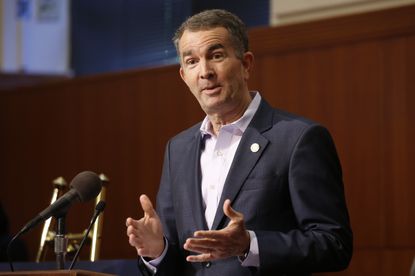VM- Gov. Ralph Northam announced Monday that Virginia will launch the first phase of its reopening plan on May 15.
The announcement comes before a 14-day downward trend in new COVID-19 cases or a decline in hospitalization numbers — metrics Northam previously said the state would need to meet before loosening the business and social distancing restrictions that have become the new normal for Virginians since March.
While testing has increased, it’s still below the 10,000 per day that Northam set as a goal for the state. But officials said that ongoing increases in testing capacity, combined with a stable supply of personal protective equipment and hospital beds, were enough to gradually reopen businesses without endangering Virginians or exhausting the state’s medical infrastructure.
“You have to look at the whole picture,” Health Commissioner Norm Oliver said after the briefing. “The fact that our hospitals are in a situation where they could handle a surge means a lot. That we have enough PPE right now means a lot, too.”
By next Friday, the restrictions on restaurants, recreation and personal care businesses such as hair salons and spas will be lifted and replaced with industry-specific guidelines that Northam said will allow business owners to operate without endangering residents.
Those guidelines have not yet been released, though the governor’s recently convened business task force delivered its recommendations last week, according to The Virginian-Pilot.
Northam also announced that he would modify his stay-at-home order, which is set to expire on June 10, to a “safer at home” order that gives residents more leeway in venturing outside their homes for non-vital tasks. Oliver said that the state would still encourage telework and social distancing measures, including restrictions on gatherings of more than 10 people. But Northam said the new rules will make it possible for Virginians to dine out, go to the gym and visit barbershops under new
safeguards.
“Here’s the bottom line,” he added. “You’ll be able to get your hair cut, but you’ll need an appointment. It means you can go out to eat again, but restaurants will use less of their seating to spread people out. Phase One means more retail establishments can be open, but they’ll have to operate at lower capacity.”
The new guidelines align Virginia more closely with southern neighbors, including Tennessee and Georgia, than with other regional partners including Maryland and Washington, D.C. While Maryland Gov. Larry Hogan introduced a roadmap for reopening the state on April 24, the state has yet to set a date for easing restrictions. D.C. Mayor Muriel Bowser’s stay-at-home order is set to expire on May 15, but she hasn’t announced whether the order will be extended or businesses will reopen on the samedate.
Northam said that the first phase of his reopening plan is likely to extend for three weeks before the state moves to further relax its restrictions. Phase Two will likely retain a stay-at-home order for vulnerable populations, but will allow larger gatherings of up to 50 people while keeping current recommendations on telework and wearing face coverings in public.
Phase Three will remove the ban on social gatherings, remove the capacity limits on business establishments, and allow vulnerable populations to leave the house for non-vital tasks, according to the governor’s presentation. The final stage of the reopening plan could be 10 to 12 weeks away and depends on a sustained decline in deaths, hospitalizations and new cases, Northam said.
“This virus is still here. It has not gone away and it will not go away until we have a vaccination,” Northam said. “So all of our efforts have slowed its spread but they have not cured the disease.”
Metrics from the Virginia Department of Health show that deaths in the commonwealth are continuing to rise, as are the total number of confirmed cases as testing increases.
State Epidemiologist Dr. Lilian Peake said the state was also considering the percentage of COVID-19 tests with positive results, a metric she said was only recently emphasized by the World Health Organization. Those rates have been declining since late April as Virginia gradually increases its COVID-19 testing, though they’re currently hovering between 15 and 20 percent.
The percentage of positive results can provide more insight on the severity of COVID-19 outbreaks in different areas and whether transmission is accelerating or abating. But experts say it also has limitations depending on the rate of testing. High positive rates are often a sign that tests are being directed to the most vulnerable individuals who are more likely to have positive results. As a result, the insight they provide is largely dependent on testing a wide segment of the population.
Oliver said that Virginia’s testing guidelines, which still emphasize hospitalized patients and other at-risk groups, are set to be expanded this week. The state is also scheduled to receive 200,000 swabs from the Federal Emergency Management Agency in both April and May, which Oliver hopes will alleviate shortages of the critical medical supplies that make testing possible on a wider level.
VPM reported Sunday that the state has still received a fraction of the swabs it’s requested from FEMA, even as new shipments continue to arrive. Doctors across the state have also reported being dependent on large commercial laboratories such as LabCorp and Quest for testing kits, drastically limiting the number of patients they can test for COVID-19 every month.
While Northam said Monday that Virginia “didn’t have as many swabs as we would like,” both doctors and official say that medical supply chains are gradually expanding to meet the growth in demand. The federal Food and Drug Administration has also announced plans to allow a broader range of swabs, though independent labs still have to verify that the new collection materials don’t affect the accuracy of their COVID-19 tests.
“I’d be surprised if we weren’t doing 10,000 tests a day by next week,” Oliver said after the briefing.



